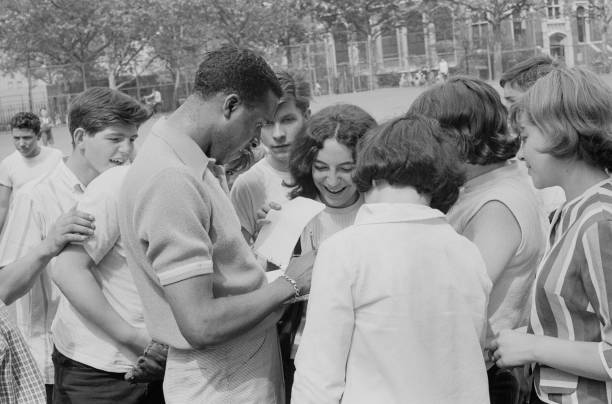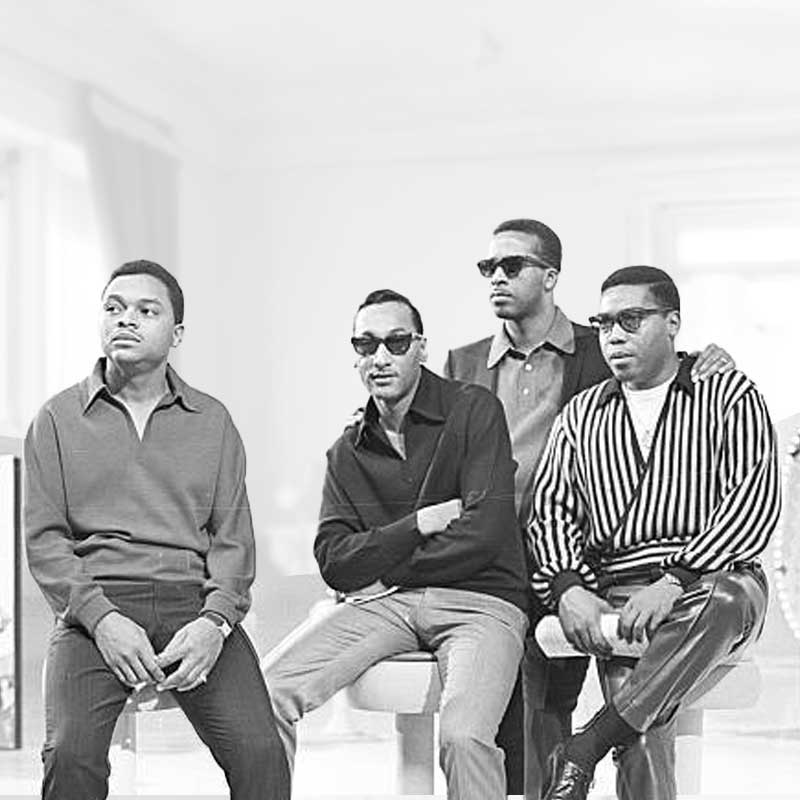“Reach Out I’ll Be There” is a light in the darkness — an achingly tender declaration of commitment and compassion delivered with the force of rolling thunder. Released in August 1966 following a summer of mounting civil unrest and violent rebellion, the Four Tops’ humanist anthem remains a bottomless reservoir of strength and succor through all times of turmoil, its physical and emotional impact unmatched across the Motown Records canon. “To me, it felt like a chant, almost religious — a song of hope for the world,” the group’s Duke Fakir proclaimed nearly half a century after the single stampeded to the top of the Billboard charts.
The Four Tops were no strangers to the spirit of solidarity “Reach Out I’ll Be There” espoused: the original lineup remained together for more than four decades without a change in personnel. Abdul “Duke” Fakir and fellow Detroit Pershing High student Levi Stubbs first sang opposite Northern High’s Renaldo “Obie” Benson and Lawrence Payton in 1953 while attending a mutual friend’s birthday party, and the teens continued performing together as the Four Aims after graduating the following spring. Support gigs behind the likes of Billy Eckstine, Count Basie, Della Reese, Betty Carter and Brook Benton honed the Four Aims into a versatile nightclub act, and with the help of Payton’s songwriter cousin Roquel “Billy” Davis, the group signed to Chess Records in 1956, issuing its label debut “Kiss Me Baby” under the Four Tops moniker to avoid confusion with pop crooners the Ames Brothers. The single went nowhere, and it would be four years before the Four Tops returned to the studio, signing to Columbia to cut the little-noticed “Ain’t That Love.”

The Four Tops spent the intervening years touring the U.S. in a broken-down station wagon, appearing everywhere from Las Vegas nightclubs to borscht-belt resorts, and though some critics dismissed the group as a glorified barbershop quartet, Motown founder Berry Gordy Jr. (Billy Davis’ onetime songwriting partner) saw something more. “Their vocal blend was phenomenal,” Gordy writes in his autobiography, To Be Loved. “Smooth, classy and polished, they were big stuff. I wanted them bad. I could see how loyal they were to each other, and I knew they would be the same way to me and Motown.”
In 1962, Gordy invited the Four Tops to his office inside Motown’s Hitsville USA campus, where Stubbs spoke on behalf of the group, stating “We’d like to sign with you, but we heard you won’t let artists take the contracts away from the office.” Gordy acknowledged this was true, but offered to let Four Tops manager Shelly Berger visit Motown to review the contract prior to signing. Gordy then launched into his standard sales pitch, which emphasized the label’s dedication to artist development as well as its remarkable knack for churning out hit singles. The Four Tops listened carefully, but again asked for a copy of the contract so their attorney could review the document at his leisure. Gordy consented, against his own better judgment — and the group did not return for more than a year.
The Four Tops finally signed with Motown in April 1963 for a modest $400 advance, admitting to Gordy that while they objected to the terms of the original contract, their greatest concern was whether a Black-owned independent label could survive in the cutthroat world of the recording industry — fears Motown’s runaway success allayed, although their wives (former showgirls all) continued to express misgivings about abandoning the lucrative supper club circuit in favor of pursuing a career as a recording act. These concerns proved correct when Motown assigned the group to its Workshop Jazz imprint to record a collection of standards, Breaking Through, that would remain stuck in the vaults for more than 30 years. Gordy then asked the fast-rising writing and producing team of Lamont Dozier and brothers Brian and Eddie Holland to craft a single that would modernize and Motown-ify the Four Tops sound: Holland-Dozier-Holland, who in 1963 alone masterminded classics including Martha and the Vandellas’ “Heat Wave,” the Miracles’ “Mickey’s Monkey” and Marvin Gaye’s “Can I Get a Witness,” immediately gravitated to Stubbs’ bellowing baritone, deeming its melancholy and majesty perfect for the trio’s latest studio creation, the poignant “Baby I Need Your Loving.”

“This is what [H-D-H] did,” an unnamed former Motown engineer told Nelson George, author of Where Did Our Love Go? The Rise and Fall of the Motown Sound. “They’d record music tracks, and conceptually they might have an idea of who’d be right for it, but they really didn’t know. They had basic instruments: the rhythm section, the horns, the strings. Brian or Lamont would take those tracks and edit them into the musical sequence that he thought the record should follow, and Eddie would try to write lyrics to it. They would do this four or five times until they got the perfect song. And then they’d go out and try to get different artists, and whoever had the best thing got it.”
In the case of “Baby I Need Your Loving,” Brian Holland approached Stubbs during a Motown showcase at the 20 Grand, Detroit’s premier entertainment venue for Black audiences. “Brian said ‘I think we’ve got a number one record for you,’ and I said ʻWell, yeah, we’d like to hear it!’” Stubbs later recalled. “This was about 1:30 at night. We said ʻWell, why don’t we wait until the show is over and go over there [to Motown’s Hitsville recording studio] and have a listen,’ because the club closed at 2:00 a.m. So we went down and stayed there until 8:00 in the morning and cut it — and it was a smash.” While “Baby I Need Your Loving” did not top the charts as Brian Holland predicted, it climbed to number 11 on the Billboard Hot 100 in the fall of 1964, and sold more than a million copies.
The Four Tops continued their partnership with the Holland-Dozier-Holland triumvirate on a series of commercially disappointing follow-ups, but all involved righted the ship with the ebullient “I Can’t Help Myself,” one of the biggest hits of 1965. Stubbs remained in the spotlight, separating the Four Tops from the myriad male and mixed vocal groups featuring tenor leads (chief among them the Temptations, their fiercest in-house rivals).
“Stubbs personifies one of my ideas of what a singer ought to be: a huge presence, vibrating with spiritual energy as he puts his song across. As he is even here, on the most confectionery piece of material he ever had,” writes critic Dave Marsh in his book The Heart of Rock & Soul: The 1001 Greatest Singles Ever Made, which ranks “I Can’t Help Myself’ number 713 overall. The record spent nine weeks atop the Billboard R&B charts as well as two non-consecutive weeks dominating the Hot 100, and its cheekily-titled soundalike sequel, “It’s the Same Old Song,” soared to number two on the R&B charts and number five on the pop countdown.

“Reach Out I’ll Be There” was the first of 12 tracks completed for the Four Tops’ fourth Motown album, Reach Out, produced at Hitsville by Holland-Dozier-Holland between July 1966 and March 1967. Reach Out, which also features the hits “Standing in the Shadows of Love,” “Bernadette” and “7 Rooms of Gloom” — “songs full of dramatic pauses, swelling instrumental passages and unexpected rhythmic changes,” notes Nelson George — represents the pinnacle of the H-D-H aesthetic. “Brian Holland had been listening to a great deal of classical music, and studied the dynamics of tension and release so important to the form,” George writes in Where Did Our Love Go? “As the records grew more complex-sounding, the time Brian took to record them grew. ‘Reach Out,’ for example, took almost two hours to cut, a marathon session by Motown standards circa 1966.”
“Reach Out I’ll Be There” drew inspiration from a wide range of sources. Dozier told The Wall Street Journal he set out to “create a mind trip — a journey of emotions with sustained tension, like a bolero. To get this across, I alternated the keys, from a minor, Russian feel in the verse to a major, gospel feel in the chorus.” Dozier and Motown studio mainstay Paul Riser collaborated on the song’s spellbinding arrangement, which begins with the exotic pairing of a flute and piccolo, the latter played by 14-year-old Dayna Hartwick, making her Hitsville USA session debut.
“The piccolo’s piercing sound was essential,” Riser explained. “It’s like a siren and gets your attention right away. It’s also the sound of a heart crying. A flute alone would have been too warm and comforting. The hoof-beat drum pattern that follows was made using timpani mallets on the plastic head of a tambourine without its little metal cymbals. That sounded like a heartbeat speeding up and raised anticipation. All of these things were used to set the mood.” As for the lyrics — a stirring pledge of unyielding love and support, even in the bleakest moments — Dozier and Eddie Holland borrowed from a contemporary source: Bob Dylan, whose folk-rock masterpiece “Like a Rolling Stone” revolutionized pop radio the previous summer.

“Brian, Lamont and Eddie could make you a song that fitted like a suit,” Fakir told The Guardian in 2014. “We were all in the studio one day when they said they wanted to try something experimental. They had this thumping backing track played by the Funk Brothers. The sound was fabulous, but then Eddie said they wanted Levi to do Bob Dylan-type singing over it. Levi was uncomfortable at first. He said ‘I’m a singer. I don’t talk or shout.’ But we worked on it for a couple of hours, recording it in pieces, talking part after talking part. Eddie realized that when Levi hit the top of his vocal range, it sounded like someone hurting, so he made him sing right up there. Levi complained, but we knew he loved it. Every time they thought he was at the top, he would reach a little further until you could hear the tears in his voice. The line ‘Just look over your shoulder’ was something he threw in spontaneously. Levi was very creative like that, always adding something extra from the heart.”
Motown issued “Reach Out I’ll Be There” on Aug. 18, 1966, at the absolute peak of the company’s creative and commercial powers: a staggering 49 of the 149 singles Motown released that year reached the charts, in an industry where other companies were fortunate to enjoy a 10 percent annual success rate. Adam White, later a senior executive at Universal Music Group, was a typical 19-year-old Motown fan when “Reach Out I’ll Be There” first materialized at radio. “I couldn’t believe this extraordinary music was coming out of that car radio speaker,” White recalled to Gerald Posner, author of Motown: Music, Money, Sex and Power. “It’s a moment I can never forget. That’s the power Motown music had then. It was simply the most dynamic, vibrant music I ever heard.”
The Four Tops were flabbergasted when Motown selected “Reach Out I’ll Be There” for release, however. “We just assumed it was some experimental thing that would go on an album,” Fakir told The Guardian. “A few weeks later, Berry Gordy sent us a memo: ‘Make sure your taxes are taken care of, because we’re going to release the biggest record you’ve ever had.’ He called us into his office, and I remember one of us asking ‘So when are we going to record this great song?’ He said ‘You already have.’” When Gordy played “Reach Out I’ll Be There,” the Four Tops begged him to reconsider, to no avail. “I was out driving when I heard the song on the radio for the first time. It hit me like a lead pipe,” Fakir confessed. “I turned my car round and drove right back to Berry’s office. He was in a meeting, but I opened the door and just said ‘Berry, don’t ever talk to us about what you’re releasing. Just do what you do. Bye.’”

Motown unleashed “Reach Out I’ll Be There” into an America as deeply divided as the nation we presently occupy. At the beginning of 1966, the number of U.S. military personnel in South Vietnam totaled 184,300; in the 12 months that followed, the Selective Service System drafted 382,010 additional citizens into military duty, the highest total of any year during the Vietnam conflict. On May 15, the activist group Students for a Democratic Society spearheaded its first anti-war protest, the March Against the Vietnam War, a rally that brought about 25,000 supporters to Washington, D.C. and gave rise to a wave of student protests and sit-ins voicing young America’s opposition to the nation’s deepening involvement in Southeast Asia. The Student Nonviolent Coordinating Committee (SNCC), one of the key organizations in the American civil rights movement, announced its opposition to the Vietnam War all the way back in January; in June, SNCC chairman Stokely Carmichael called on Black Americans to embrace Black Power, which became an ideological rallying cry for young people frustrated by the glacial pace of societal change. Confrontations between white authorities and Black citizens reached a crescendo in July 1966, when in a span of three weeks, rioting erupted in Omaha, Chicago, New York and Cleveland.
“Reach Out I’ll Be There” hit Detroit radio stations nine days after an event local historians dubbed the Kercheval Incident, which foreshadowed the violence and bloodshed that would consume the city in the long, hot summer of 1967. Around 8:25 pm on Tuesday, Aug. 9, a police cruiser driven by white officers approached seven Black men standing on the sidewalk near the intersection of Kercheval and Pennsylvania Avenues (about seven miles east of Motown headquarters) and ordered them to “move on.” Four men complied, but the other three — Wilbert McClendon and James Roberts, members of the Afro-American Youth Movement (AAYM), a direct-action civil rights organization formed in 1965 to address racial inequalities on Detroit’s East Side, and neighborhood resident Clarence Reed — refused. The police ticketed them for loitering, and when the men refused to show their identification, the officers called for backup.
By the time a pair of squad cars arrived at the scene, a crowd of roughly 50 residents had gathered, and as the police took Roberts into custody, a scuffle broke out. Roberts, McClendon and Reed were subdued by authorities, and charged with inciting to riot and resisting an officer; the crowd continued to amass, however, and some began berating the police and throwing bottles. Residents also whispered that the officers had broken one of the men’s arms — or worse. Finally, about 150 police officers in riot gear descended on the scene, armed with canisters of tear gas and bayonets mounted on their rifles. Thirteen people were injured, including four police officers, and six were arrested.

“What happened was a response on the part of an oppressed people to the most obvious form of their oppression: the police department,” AAYM director Alvin Harrison stated in the aftermath of the Kercheval Incident. “What happened was not spontaneous in that it was set off by a single incident. What happened was the result of years of oppression.”
Then as now, “Reach Out I’ll Be There” offered a balm for the soul — “strong medicine for chronic despair, as hopeful as any Black anthem during the Sixties,” Jeremy Helligar wrote for Variety in 2021. “But it didn’t just offer hope to the broken. It led by example. Stubbs so convincingly conveyed undying loyalty that he likely left listeners wishing and hoping for that kind of unwavering devotion and perhaps inspired them to extend it, too. It was exactly what a Black America reeling from the injustices of systemic racism, in the middle of a civil rights movement, needed to hear in 1966. It’s what we still need to hear [today].”

“Reach Out I’ll Be There” topped the Billboard Hot 100 for two weeks in mid-October, spending the same period of time at the summit of the R&B charts. It was also the second Motown single to reach number one on the U.K. pop charts, two years after the Supremes’ “Baby Love.” The Four Tops dominated radio in the coming months as the Reach Out album continued to pay dividends, but in 1967 Holland-Dozier-Holland tangled with Berry Gordy over profit sharing and royalties, and in early 1968 the trio split from Motown to form their own Invictus and Hot Wax labels. The Four Tops struggled in H-D-H’s absence before rebounding in collaboration with producer Frank Wilson, who helmed their 1970 hit “It’s All in the Game” as well as the full-length Still Waters Run Deep, an early concept album.
When Motown relocated to Los Angeles in the summer of 1972, the Four Tops remained in Detroit and signed to ABC-Dunhill, where they recorded the million-selling “Ain’t No Woman (Like the One I’ve Got)” the following year. The group eventually returned to Motown in 1983, reuniting with Holland-Dozier-Holland for the LP Back Where I Belong. Lawrence Payton’s death from liver cancer in 1997 brought to an end the original Four Tops lineup’s remarkable 44-year run; the surviving trio added Ronnie McNeir and continued touring, but following the deaths of Stubbs and Obie Benson, only Duke Fakir remained from the group’s heyday by the time Joe Biden adopted their original recording of “Reach Out I’ll Be There” for his 2020 presidential run.

“Holland-Dozier-Holland are now regarded as legendary, but at the time they were just twentysomething boys constantly searching for something new, in the same way as the Beatles were,” Shelly Berger said in 2014 when he looked back on “Reach Out I’ll Be There.” “That’s what the Tops needed, because by 1966 they were so huge, there was no way of taking them to another level commercially — only artistically.”






